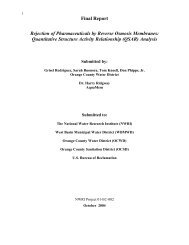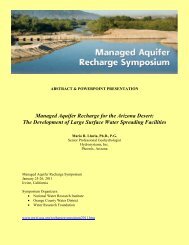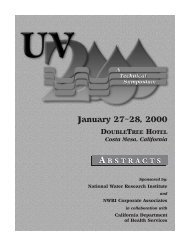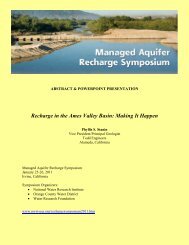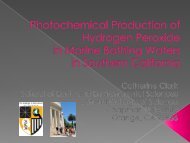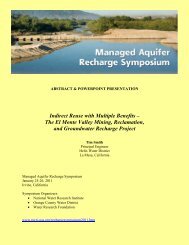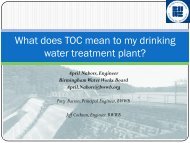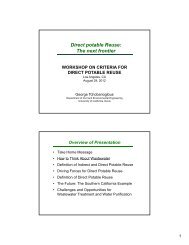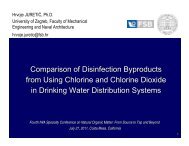RBF_Cover (for eps) - National Water Research Institute
RBF_Cover (for eps) - National Water Research Institute
RBF_Cover (for eps) - National Water Research Institute
Create successful ePaper yourself
Turn your PDF publications into a flip-book with our unique Google optimized e-Paper software.
Session 5: Dynamics<br />
Temporal Changes of Natural Attenuation Processes<br />
During Bank Filtration<br />
Paul Eckert, Ph.D.<br />
Stadtwerke Düsseldorf AG<br />
Düsseldorf, Germany<br />
Rudolf Irmscher, Ph.D.<br />
Stadtwerke Düsseldorf AG<br />
Düsseldorf, Germany<br />
<strong>RBF</strong> is a well-proven natural purification step in water supply. Sustainable water management<br />
should be based specifically on natural purification methods, as declared by the International<br />
Association of <strong>Water</strong>works in the Rhine Catchment Area, in their 2003 memorandum. To<br />
achieve this aim, a profound knowledge of the purification capacity of bank filtration is essential.<br />
At the Düsseldorf <strong>Water</strong>works in Germany, the influence of long-term — as well as periodic —<br />
changes of both hydraulics and river-water quality on natural attenuation processes were<br />
investigated.<br />
The improvement of Rhine River water quality over the last 30 years enabled the Düsseldorf<br />
<strong>Water</strong>works to reduce their technical treatment expenses. Temperature variations throughout the<br />
year and flood events significantly influenced the purification capacity of bank filtration. This<br />
rein<strong>for</strong>ces the need <strong>for</strong> flexible technical treatment methods capable of adapting to changing rawwater<br />
quality.<br />
Even though the complete replacement of subsequent technical treatment st<strong>eps</strong> might be seen as<br />
an unreachable vision, the substantial knowledge we have acquired on the purification capacity<br />
of bank filtration enables the design of tailor-made treatment methods.<br />
Site Description and Treatment Concept<br />
The City of Düsseldorf is situated in northwestern Germany, in the lower Rhine Valley (Figure 1).<br />
The Düsseldorf <strong>Water</strong>works supply 600,000 inhabitants with treated bank filtrate. A multiprotective<br />
barrier concept ensures the constant production of high-quality drinking water (Figure 2).<br />
Natural attenuation processes during bank filtration <strong>for</strong>m the first and most efficient protective<br />
barrier. The subsequent protective barrier is raw-water treatment, including ozonation, biological<br />
active filtration, and active carbon adsorption.<br />
The Rhine River has a length of 1,320 kilometers and a catchment area of 185,000 square kilometers;<br />
it is the third biggest river and the largest source of drinking water in Europe. The mean discharge<br />
of the Rhine at Düsseldorf is 2,200 m 3 /s, while the <strong>Water</strong>works use less than 2 m 3 /s. During flood<br />
events, discharge increases up to 9,900 m 3 /s.<br />
Correspondence should be addressed to:<br />
Paul Eckert, Ph.D.<br />
Head of the <strong>Water</strong> Management Department<br />
Stadtwerke Düsseldorf AG<br />
Abt. Wasserwirtschaft • Höherweg 100 • 40233 Düsseldorf, Germany<br />
Phone: +0211/8218359 • Fax: +0211/821778359 • Email: peckert@swd-ag.de<br />
87



